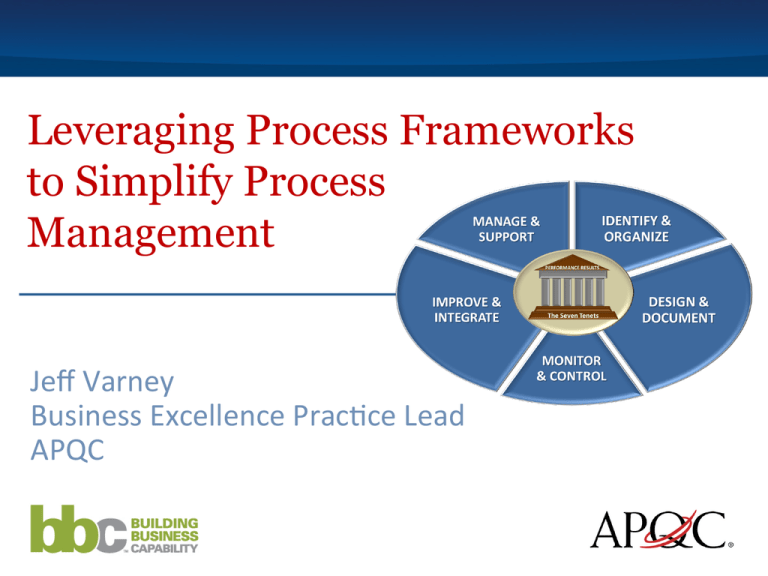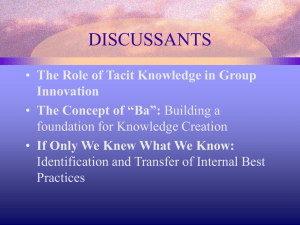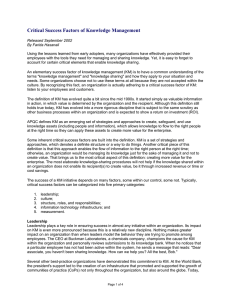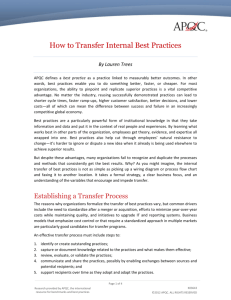
Leveraging Process Frameworks
to Simplify Process
Management
Jeff Varney Business Excellence Prac3ce Lead APQC Objectives
Many people inherently sense the value of a process framework but struggle to realize the benefit within their organiza3ons In this presenta3on we will discuss… Key principles that make frameworks effec3ve Overcoming barriers to end-­‐to-­‐end process management Aligning to what leaders care about Accelera3ng your journey to higher process-­‐
based performance ©2013 APQC. ALL RIGHTS RESERVED. 2 What is a Process Framework?
A process framework is a list of business processes that are: ü mutually exclusive, ü collec:vely exhaus:ve, and ü hierarchically decomposed ©2013 APQC. ALL RIGHTS RESERVED. 3 Process Classification Frameworks
at APQC
Industry Versions Aerospace & Defense Automo3ve Banking Broadcas3ng Consumer Electronics Consumer Products Educa3on Electric U3li3es Health Insurance Payer Petroleum Downstream Petroleum Upstream Pharmaceu3cal Retail Telecommunica3ons Best prac:ce organiza:ons blend and tailor these to best represent their businesses ©2013 APQC. ALL RIGHTS RESERVED. 4 A Look Inside the PCF
©2013 APQC. ALL RIGHTS RESERVED. 5 Frameworks are Fundamental
Organize your structure for process informa3on on the front end! If you don’t…
n
Process informa3on will eventually be built in pieces by dozens of people and projects. n
You will struggle to integrate process informa3on across your organiza3on. ©2013 APQC. ALL RIGHTS RESERVED. 6 Primary Uses of Frameworks
Manage Content Accelerate Governance List of all processes Structure Iden3fy Process Owners Align to Strategy Evaluate poten3al for improvement Manage Content Benchmarking What to measure Aggregate/Drill-­‐down ©2013 APQC. ALL RIGHTS RESERVED. 7 Reusable Processes Cross-­‐Func3onal Processes Focus Deployment for Value
Strategic alignment of processes n
High-­‐value ini3a3ve n
High-­‐value products n
Processes requiring high integrity (i.e. where mistakes are costly) ‘Size of the crowd’ around any one process n
Number of individuals/teams/processes using a specific part of the framework Business value is ul3mate purpose of framework ©2013 APQC. ALL RIGHTS RESERVED. 8 Deployment Approaches
Reorganize ALIGN organiza3onal elements to framework n
n
n
Costly and difficult—seldom successful approach Organized around func3ons in the process framework Similar to reengineering approach (Excep9on – mergers or dives9tures) Ø At most disrup3ve—restructures the organiza3on chart to match process framework Ø At least disrup3ve—changes the organiza3on chart to resolve gaps or overlaps
Overlay MAP exis3ng structures to framework n
Faster—less opposi9on ©2013 APQC. ALL RIGHTS RESERVED. 9 Cross-Functional Processes Exist…
... but when they are not managed n
Processes are ad-­‐hoc and inconsistent n
Management is unmonitored and uncontrolled n
Management is using poor or inappropriate measurements – if measuring at all n
Process workers have limle insight into upstream and downstream impacts ©2013 APQC. ALL RIGHTS RESERVED. 10 Defining Cross-Functional Processes
Best prac3ce organiza3ons leverage frameworks to define cross-­‐func3onal flow Refer to consistently defined and commonly used building blocks n
n
Defini3on is based upon specific elements of process framework Contextual reference is valuable to iden3fy process gaps and overlaps Iden3fy each sub-­‐process n
n
Consistent documenta3on Accurate defini3on ©2013 APQC. ALL RIGHTS RESERVED. 11 Crucial Cross-Functional Processes Can
Often Require Multiple Handoffs
6.0 Develop & Manage Human Capital 7.0 Manage Informa:on Technology 8.0 Manage Financial Resources 9.0 Acquire, Construct, and Manage Property 10.0 Manage Environmental Health and Safety (EHS) 11.0 Manage External Rela:onships 12.0 Manage Knowledge, Improvement, Change ©2013 APQC. ALL RIGHTS RESERVED. 4.0 1.0 2.0 3.0 Develop Develop & Market and Deliver Products Vision and Manage Sell Strategy Products Products & Services & Services & Services Build N
ew Facility 12 5.0 Manage Customer Service Cross-Functional Process Strategies
Thousands of cross-­‐func3onal processes exist in typical organiza3on n
n
n
n
n
Focus on cri3cal few Iden3fy owner early Orchestrate components Iden3fy first, improve later Go only as far as you need to go— make sure what you are doing is valuable ©2013 APQC. ALL RIGHTS RESERVED. 13 Cross-Functional Process Governance
Each iden3fied cross-­‐func3onal process must have an owner n
n
n
n
May not perform the process themselves Accountable for process results, integrity, and improvement Open a func3onal or product manager Open one of many that rely on the process Ø
Ø
Act as a focal point for the process Coordinate and collaborate to gain buy-­‐in ©2013 APQC. ALL RIGHTS RESERVED. 14 Real World Cross-Functional Example:
Order-to-Cash
Take Orders
Fulfill Orders Shipping & Logis:cs Invoicing, Payment & Receipt Assump3ons n Marke3ng is complete n Organiza3on is ‘build to stock’ rather than ‘build to order’ n Offer terms of ‘Net 30’ n Products are in stock n No customer order inquiries ©2013 APQC. ALL RIGHTS RESERVED. 15 Example:
OTC – High-Level
Which process categories are involved? §
3.0 Market and Sell Products and Services §
4.0 Deliver Products and Services §
8.0 Manage Financial Resources ©2013 APQC. ALL RIGHTS RESERVED. 16 Example:
3.0 Market& Sell Products/Services
(Take Orders & Check Availability)
Take Order Check Availability ©2013 APQC. ALL RIGHTS RESERVED. 17 Example:
4.0 Deliver Products/Services
(Fulfill Orders, Shipping & Logistics)
Pick, Pack & Ship Deliver ©2013 APQC. ALL RIGHTS RESERVED. 18 Example:
8.0 Manage Financial Resources
(Invoicing, Payment & Receipt)
Check Credit (part of sale?) Invoicing Payment & Receipt ©2013 APQC. ALL RIGHTS RESERVED. 19 Analyze How Pieces Fit Together
3.5 Develop and Manage Sales Plans 3.5.4 Orders Manage Sales 8.2.1 Process Customer Credit ORDER TO CASH 4.5 Manage Logis:cs and Warehousing 4.5.3 4.5.4 Operate Operate Outbound Warehousing Transporta:on 8.2 P erform Accoun:ng Revenue 8.2.2 Invoice Customer ©2013 APQC. ALL RIGHTS RESERVED. 20 8.2.3 Process Accounts Receivable Example of Cross-Functional Process
©2013 APQC. ALL RIGHTS RESERVED. 21 Benefits Take Effort to Realize
Benefits may be elusive if you don’t monitor and control n
n
n
n
Establish performance targets Support roll-­‐out and transi3on Measure and evaluate effec3veness Communicate and collaborate with all players Uncoordinated changes may break con3nuity ©2013 APQC. ALL RIGHTS RESERVED. 22 Summary
Key principles that make frameworks effec3ve n
Overcoming barriers to end-­‐to-­‐end process management n
n
Ownership of both framework elements and cross-­‐func3onal processes Focus on cri3cal few Aligning to what leaders care about n
n
What, not how Evaluate elements in framework for impact Priori3ze, select and manage improvements Accelera3ng your journey to higher process-­‐based performance ©2013 APQC. ALL RIGHTS RESERVED. 23 123 North Post Oak Lane Houston Texas 77024-­‐7797 1-­‐713-­‐681-­‐4020 1-­‐800-­‐776-­‐9676 www.APQC.org ©2013 APQC. ALL RIGHTS RESERVED. 24






